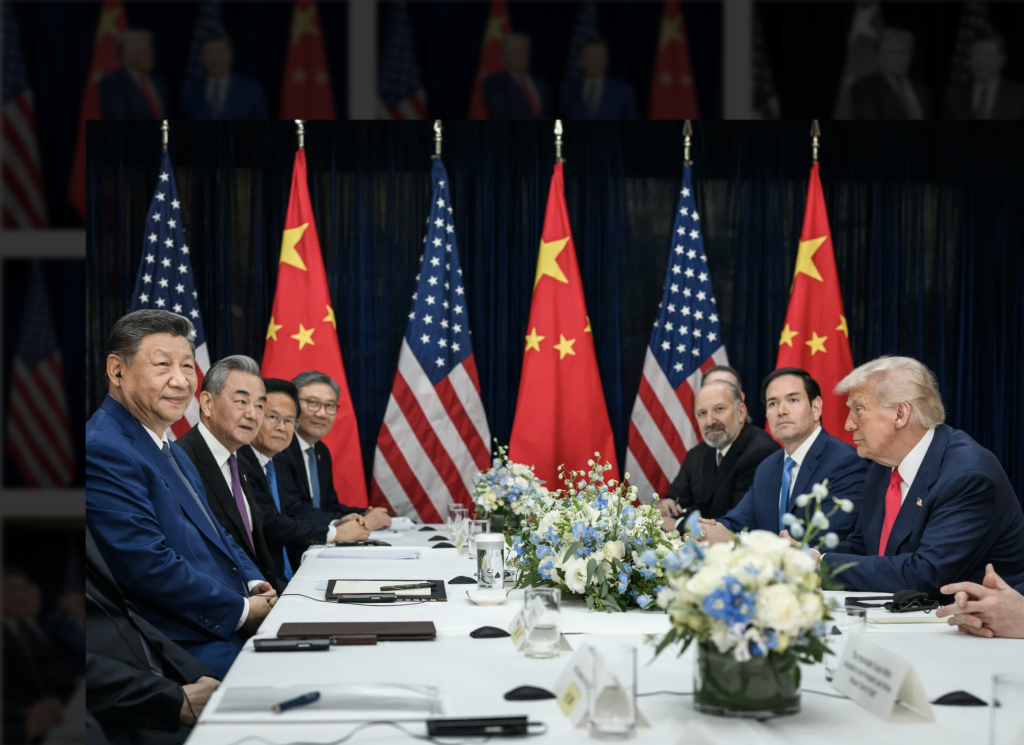How Capable Are the U.S. and Japan of Intervening in a Taiwan Conflict?
China’s Internet Evolution: Sitting down with Guo Shaohua
Shaohua Guo is an Associate Professor of Chinese, Asian Languages & Literatures at Carleton College. She received her BA and MA from Beijing Normal University and her doctoral degree from the University of Texas at Austin. Her research interests focus on contemporary Chinese studies, digital media studies, and cultural studies. This interview with her is on her book, The Evolution of the Chinese Internet: Creative Visibility in the Digital Public (Stanford University Press, 2020), which examines the emergence of four powerful internet platforms in China: the bulletin board system, the blog, the microblog, and WeChat. You can read more about the book here.
As you mention in your book, early studies of the Chinese internet largely fall under one of two categories— “narratives of revolution” and “narratives of closure.” The former concept argues that digital technologies will ultimately facilitate the progress of political democratization in China, while the latter one suggests that Chinese digital technologies are always controlled by the state to help the suppression of free speech and human rights. Why do you think this binary narrative fails to capture the full image of the Chinese internet? What important questions, you believe, are missing under this dichotomy?
These binary narratives certainly have their validity. Yet, both narratives of revolution and narratives of closure assume that technological breakthroughs will either induce a radical break away from existing sociopolitical structures or contribute to sustaining authoritarian rule. The binary opposition between the state and its citizens not only ignores the reality of a more sophisticated interplay between the two, but also results in a narrowly defined, politicized study of the Chinese Internet that neglects the daily experiences of netizens. For example, in contrast to the prominent visibility of the Chinese state and business corporations in popular media, the less told story is how the Chinese internet has created a space for diverse voices and cultural innovation. As of February 2021, China had nearly a billion internet users, who are active content contributors. What kind of content do Chinese internet users contribute online? What kind of space do they access, and how do netizens navigate digital spaces to make sense of their everyday life? And what role do internet corporations, state sectors, and commercial media play during China’s drastic transformation into digital society? These are the questions that I hope to address in this project.
You choose to study the evolution of the Chinese Internet through the lens of “network of visibility.” What is “network of visibility?” How does it differ from previous approaches to study the Chinese internet?
Previous studies of the Chinese internet contain many valuable insights. However, in contrast to the flourishing of research findings on what is made invisible online, such as monitored, censored, and removed content, we know little about the driving mechanisms that grant visibility to particular kinds of user-generated content. I propose “the network of visibility” to examine the mechanisms behind the vibrancy of online culture in China. I analyze the network of visibility through the process of competition for (1) user attention, and (2) content authority among internet corporations, media outlets, and individual players in the cultural realm. These two dimensions of competition, one emphasizing the economic rule of monetizing user attention and the other focusing on the possession and acquisition of authoritative voices, weave the network of visibility that shapes what is seen online, by whom, and in what way. In turn, the myriad ways of seeing indicate different degrees of viewer involvement with the subject matter being attended to.
By delineating the process of competition for discursive power among multifarious players, I show that the vitality of Chinese digital culture is rooted in the dynamic process of negotiation, collaboration, and contestation enacted by the interplay of diverse agents, including the state, cultural institutions, commercial entities, and Internet users. In doing so, this book highlights the pivotal roles that cultural history, technological platforms, and individual agency have played in shaping the sociopolitical meanings of the Chinese Interne
In your book, you trace the development of the Chinese internet through four dominant technological platforms: the bulletin board system (BBS), the blog, the microblog, and WeChat. For many of our readers who are not familiar with them in the Chinese context, could you provide a brief overview of the historical background and the major differences between each platform?
The bulletin board system (BBS) is the very first collaborative platform accessible to every Internet user since the mid-1990s. The early features of BBS were mainly group discussion, news posts, and file sharing. Services such as chat rooms, blogs, online games, and search engines were later incorporated. BBSs in China, in particular university BBSs, catalyzed the emergence of a new kind of public culture that encouraged debates and endorsed users’ contribution of original content. In contrast to self-publishing in the form of installments on BBS, blog entries tend to feature longer essays and highlight individual authorship. As the Chinese translation of the word “blogger” (bozhu) shows, a blogger is considered the “host” of a blog, while visitors are viewed as guests or friends (boyou) whom the host gradually gets to know. Commercial portals in China played a crucial role in popularizing blogging as a new form of writing, promoting citizen journalism, and boosting China’s entertainment culture.
The advent of microblogging (Weibo) reinvented the feature of self-publishing, transforming it into self-broadcasting, since Weibo enables the instantaneous dissemination of information in the case of time-sensitive events. Weibo also invented the “long tweet” (chang weibo) feature to incorporate the function of blogging into the microblogging platform, incentivizing this in 2014 through the integration of a payment function. Readers could “tip” (dashang) the writers they liked, while the “paid content” (fufei yuedu) feature required readers to either make payment before accessing the full text of a post or to pay a subscription fee on a weekly, monthly, or yearly basis. These moves adapted the common practices of pay-per-read originating from literary websites and monetized user-generated content on a massive scale.
Launched in 2011, WeChat evolved from a mobile messaging app into a multifunctional platform that includes text messaging, voice messages, video and audio calls, mobile payments, gaming, photo and video sharing, mini programs, personal status updates (“moments”), and public accounts (gongzhong hao). By involving a large number of players, including individuals, institutions, enterprises, and governments, WeChat public accounts also have significantly advanced the trend of self-publishing.
The Celebrity industry has become an essential component of today’s Chinese internet and the web-based economy. What comes along with this flourishing celebrity industry is the fan culture in China’s online communities. What are the major characteristics of the past and current fan culture on China’s internet? How are governmental agencies, such as People’s Daily and the Communist Youth League of China, able to use this fan culture for propaganda purposes?
Fan culture develops along with the commercialization of entertainment industry, technological affordances, and corporate and state policies. For instance, the model of “celebrity blogging” that Sina promoted in 2005 offered new opportunities for fans to interact with their idols on the comment space. Technical features of Weibo and WeChat groups further enhance the sense of interactivity and intimacy among internet users. Governmental agencies are actively appropriating fan culture to make the centralized message more approachable to the younger generation of internet audiences. Both People’s Daily and the Communist Youth League of China build a strong social media presence to cultivate their own fan base. They also reinvent language and sociality to selectively resonate with popular sentiments and to assert authority online.
In your book, chapter 5, “Taboo Breakers and Microcultural Contention,” you mention that “(Chinese) free expression has been significantly redefined via digital media.” The grand scale of activism, such as the 1989 Tiananmen protest, has gradually given away to “a ‘prosaic’ style of digital contention” in the twenty-first century. How does this lesser confrontational approach take place on the Chinese internet? What kind of role does censorship play in this change?
Censorship is one of the factors that contribute to shaping online expressions and changing style of contention. In this regard, I would like to recommend the late Professor Jing Wang’s book The Other Digital China: Nonconfrontational Activism on the Social Web (2019, Harvard University Press), which thoroughly addresses how the lesser confrontational approach of citizen activism may yield fruitful results.
Among all four platforms you examine, WeChat stands out in terms of its popularity and impact among Chinese communities all over the world. In your opinion, why is WeChat so special?
Tencent’s advertising slogan, “WeChat, a lifestyle,” summarizes the full-scale integration of this single mobile app into users’ everyday lives. WeChat is the first mobile application that reaches the same level of popularity as desktop applications like BBSs, blogs, and microblogs. All of these earlier platforms had limited appeal for the senior generation in China, some of whom are illiterate and less technologically oriented. WeChat’s easy-to-use features—such as voice messaging, video calls, and the conversion of voice messages into text—do not require language or technical literacy, which largely accounts for its popularity among seniors. In addition, the blending of ecommerce capabilities into the WeChat platform have galvanized aspiring individuals, media and cultural institutions, private enterprises and small business owners, and governments to make active use of WeChat in various ways. E-commerce also offers flexible models of commodifying original content on WeChat, ranging from the production of sponsored content to the marketing of personal brands or the offering of monetary rewards for content contributors.








